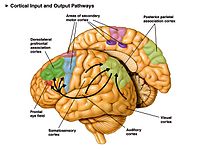
Photo from wikipedia
BACKGROUND Repetitive Transcranial Magnetic Stimulation (rTMS) over the primary motor cortex (M1) has been used to treat stroke motor sequelae regulating cortical excitability. Early interventions are widely recommended, but there… Click to show full abstract
BACKGROUND Repetitive Transcranial Magnetic Stimulation (rTMS) over the primary motor cortex (M1) has been used to treat stroke motor sequelae regulating cortical excitability. Early interventions are widely recommended, but there is also evidence showing interventions in subacute or chronic phases are still useful. OBJECTIVE To synthetize the evidence of rTMS protocols to improve upper limb motor function in people with subacute and/or chronic stroke. METHODS Four databases were searched in July 2022. Clinical trials investigating the effectiveness of different rTMS protocols on upper limb motor function in subacute or chronic phases post-stroke were included. PRISMA guidelines and PEDro scale were used. RESULTS Thirty-two studies representing 1137 participants were included. Positive effects of all types of rTMS protocols on upper limb motor function were found. These effects were heterogeneous and not always clinically relevant or related to neurophysiological changes but produced evident changes if evaluated with functional tests. CONCLUSION rTMS interventions over M1 are effective for improving upper limb motor function in people with subacute and chronic stroke. When rTMS protocols were priming physical rehabilitation better effects were achieved. Studies considering minimal clinical differences and different dosing will help to generalize the use of these protocols in clinical practice.
Journal Title: NeuroRehabilitation
Year Published: 2023
Link to full text (if available)
Share on Social Media: Sign Up to like & get
recommendations!